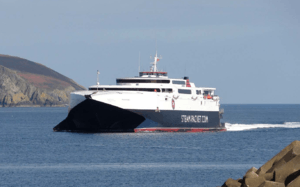SS Douglas (1889)
 RMS Douglas | |
| History | |
|---|---|
| Name: |
|
| Owner: |
|
| Operator: |
|
| Port of registry: | Douglas, Isle of Man |
| Route: | Douglas - Liverpool, Whitehaven, Fleetwood. |
| Builder: | Robert Napier & Co. |
| Cost: | Not Recorded. Purchased by the Isle of Man Steam Packet Company for £13,500. |
| In service: | 1889 |
| Out of service: | 1923 |
| Identification: |
|
| Fate: | Sunk in the River Mersey following a collision with the SS Artemisia 16 August 1923. |
| Status: | Wreck |
| General characteristics | |
| Type: | Packet Steamer |
| Tonnage: | 774 gross register tons (GRT) |
| Length: | 240 feet (73 m) |
| Beam: | 30 feet (9.1 m) |
| Depth: | 15 feet (4.6 m) |
| Speed: | 15 knots (28 km/h) |
| Capacity: | 506 passengers |
| Crew: | 33 |
SS (RMS) Douglas (III) – the third vessel in the line's history to bear the name – was a packet steamer which entered service with the London and South Western Railway in 1889 under the name Dora until she was purchased by the Isle of Man Steam Packet Company in 1901 for £13,500.
Construction & dimensions
Douglas was a steel built, single-screw vessel constructed by Robert Napier & Co. of Glasgow. She had a registered tonnage of 774 GRT; length 240 ft 0 in (73.2 m); beam 30 ft 0 in (9.1 m); depth 15 ft 2 in (4.6 m). Douglas had a certificated accommodation for 506 passengers and a crew of 33. Napier's were also responsible for her engines and boilers.
Service life
The Douglas was a departure in Steam Packet practice. Until 1901 all its ships had been ordered and built for it, with the exception of the two eminently suitable vessels Prince of Wales and Queen Victoria which had been bought in after their owners had unsuccessfully tilted at the Manx trade.
The Douglas however, was a straight purchase to fill the gap left when Peveril was sunk in 1899. The ship had been working the Southampton service to the Channel Islands and was thus very well suited to the Irish Sea trade.
In November 1903, she collided with, and sank, the steamer City of Lisbon in the Mersey. Douglas was used for winter services to and from the Island, and throughout World War I, playing a valuable part in maintaining the Island's lifeline.
Mail and cargo
Douglas was designed to carry a mixture of passengers and cargo. Her designation as a Royal Mail Ship (RMS) indicated that she carried mail under contract with the Royal Mail. For the storage of letters, parcels and specie (bullion, coins and other valuables) a specified area was allocated for the carriage of such items. In addition, there was a considerable quantity of regular cargo, ranging from furniture to foodstuffs and even motor cars.
Incidents
On Thursday September 7, 1911, the Douglas ran aground in the River Mersey as she completing passage from Douglas to Liverpool.[1]
Having left Douglas at midnight on Wednesday,[1] by the time the Douglas arrived in the Queen’s Channel a fog had lowered visibility, resulting in her running aground near the Crosby Lightship.[1]
The Douglas heeled over to port slightly, but righted as the tide made.[1] She subsequently refloated, and arrived into Liverpool at 08:30.[1]
Sinking
On 16 August 1923, Douglas pulled out of the Brunswick Dock in the River Mersey at the start of her voyage to Douglas. As she proceeded down river towards the sea, she attempted to cross the bows of the Artemisia, a ship of 5,731 tons which was inward bound to Liverpool with a cargo of sugar from Java.
Artemisia struck the Douglas amidships but the Duty Officer of the Artemisia prevented any loss of life by keeping his engines going, and holding his bows into the Douglas's side, so keeping her afloat until all crew and the 15 passengers were taken off safely. The Douglas then sank (at 53°23′0″N 3°01′0″W / 53.38333°N 3.01667°W)[2] and her wreck was destroyed nearly four months later.
The collision was followed by a lengthy and expensive legal wrangle in which it revealed that the Artmisia was waiting her turn to enter the dock and was lying a thousand feet off the entrance with just sufficient seaway to stem the flood tide. The Douglas left the dock, turned into the tidal water intending to go around the larger ship. The issue turned to one of seamanship and the Admiralty Court held that the Douglas was alone to blame. The case was heard on 5 June 1924.
The Steam Packet appealed against the decision and the appeal was allowed. This time the Artemisia was held to blame. Then came the final appeal to the House of Lords. The successful appeal was dismissed and their Lordships reversed the findings of the Appeal Court. The responsibility of the collision rested solely on the Douglas.
Gallery
| RMS Douglas. | ||||||||||
|---|---|---|---|---|---|---|---|---|---|---|
|
Official number and code letters
Official numbers are issued by individual flag states. They should not be confused with IMO ship identification numbers. Douglas had the UK Official Number 94515 and originally used the Code Letters L C G W ![]()
![]()
![]()
![]() .
.
References
| Wikimedia Commons has media related to Douglas. |
- Bibliography
- Chappell, Connery (1980). Island Lifeline T.Stephenson & Sons Ltd ISBN 0-901314-20-X


